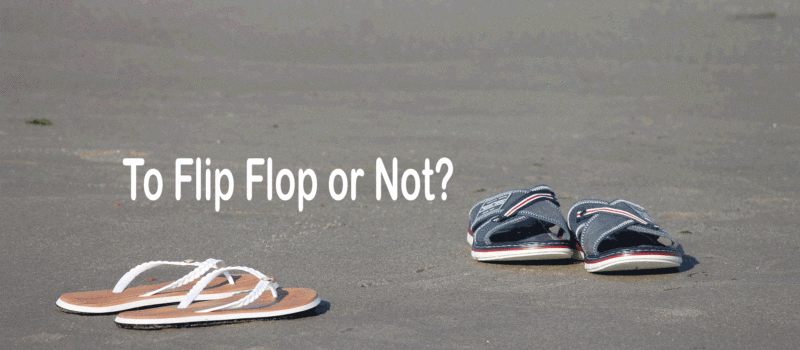
To Flip Flop or Not
Flip Flops
Mid winter dreams, the smell of spring and of course the call of the lake in the summer all bring visions of shorts, summer dresses and of course “something to wear on your feet”. In your go bag, you are almost sure to pack a pair of flip flops. These lightweight sandals are easy to pack and carry around. While they may be a good option to wear in a public change room or on a pool deck to avoid plantar warts and various fungal infections, flip flops can cause problems with long term use.
Why are flip flops a possible flop?
Flip flops have minimal arch support, no hindfoot (heel) control, often little cushioning, sometimes too much cushioning and finally they require the wearer to grip their toes to keep the sandal on the foot. These issues can contribute to an altered walking pattern and potentially lead to painful conditions such as:
- Plantar fasciitis: This occurs when the arch of the foot is overloaded and the connective tissue under the foot becomes inflamed. It is characterized by sharp pain felt to the bottom of the foot during the first few steps of the day or after a period of rest. Please see our blog posts discussing this subject and treatment options available.
- Tibialis posterior tendinopathy: The tibialis posterior muscle helps to control the lifting of the arch and can get strained with lack of support. Repetitive overuse and irritation to this structure can lead to inflammation and tendinopathy.
- Shin splints: This is characterized by painful inflammation to the connective tissue surrounding the shin bone. This can occur when the arch of the foot collapses due to lack of support and from increased tightness to the calf muscles due to gripping the toes when trying to keep loose shoes on the feet (flip flops!)
- Knee pain: Pain to the medial (inner) side of the knee can indicate stress to the medial structures of the knee including the meniscus and medial collateral ligament. These stresses can develop when the arch of the foot is not well supported causing the knee to rotate inward when standing and walking.
- Back pain and neck pain: The foot is also a shock absorber. If the arch of the foot collapses when walking, the shock is not properly absorbed. Compensation may occur further up the body to the hip and core and into the back and neck. Structures in this area can become overworked and irritated from this compensation causing pain to the neck and back.
Just Don’t Flip Flop a Lot
So, pack your flip flops for your next beach vacation but consider bringing a sturdy, breathable shoe or a proper sandal that provides cushioning and arch support along with you as well. Wear your flip flops for short durations such as to the to the pool and back but make sure that you wear better footwear for longer excursions.
Your feet, knees and back will thank you!
Special thanks to Marie-Josee Dupuis-Arsenault for her contribution to this blog!
